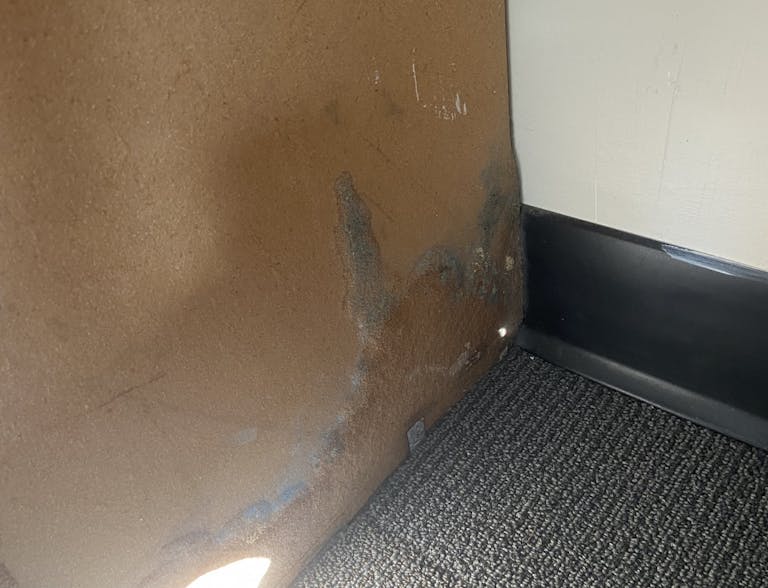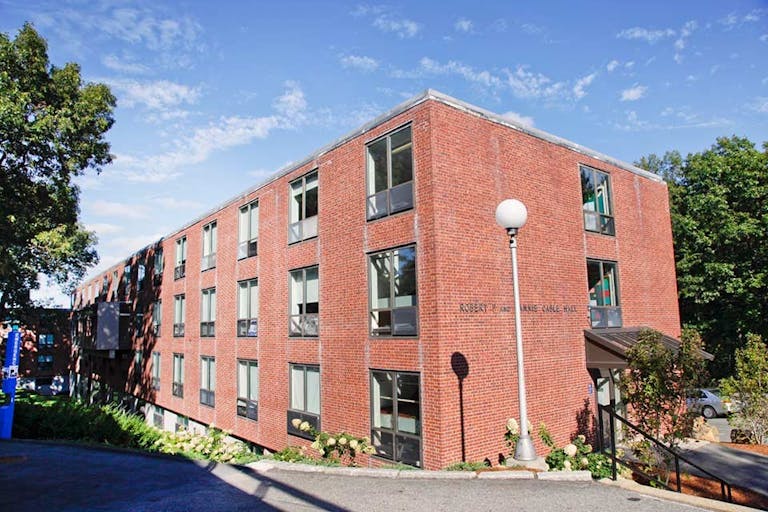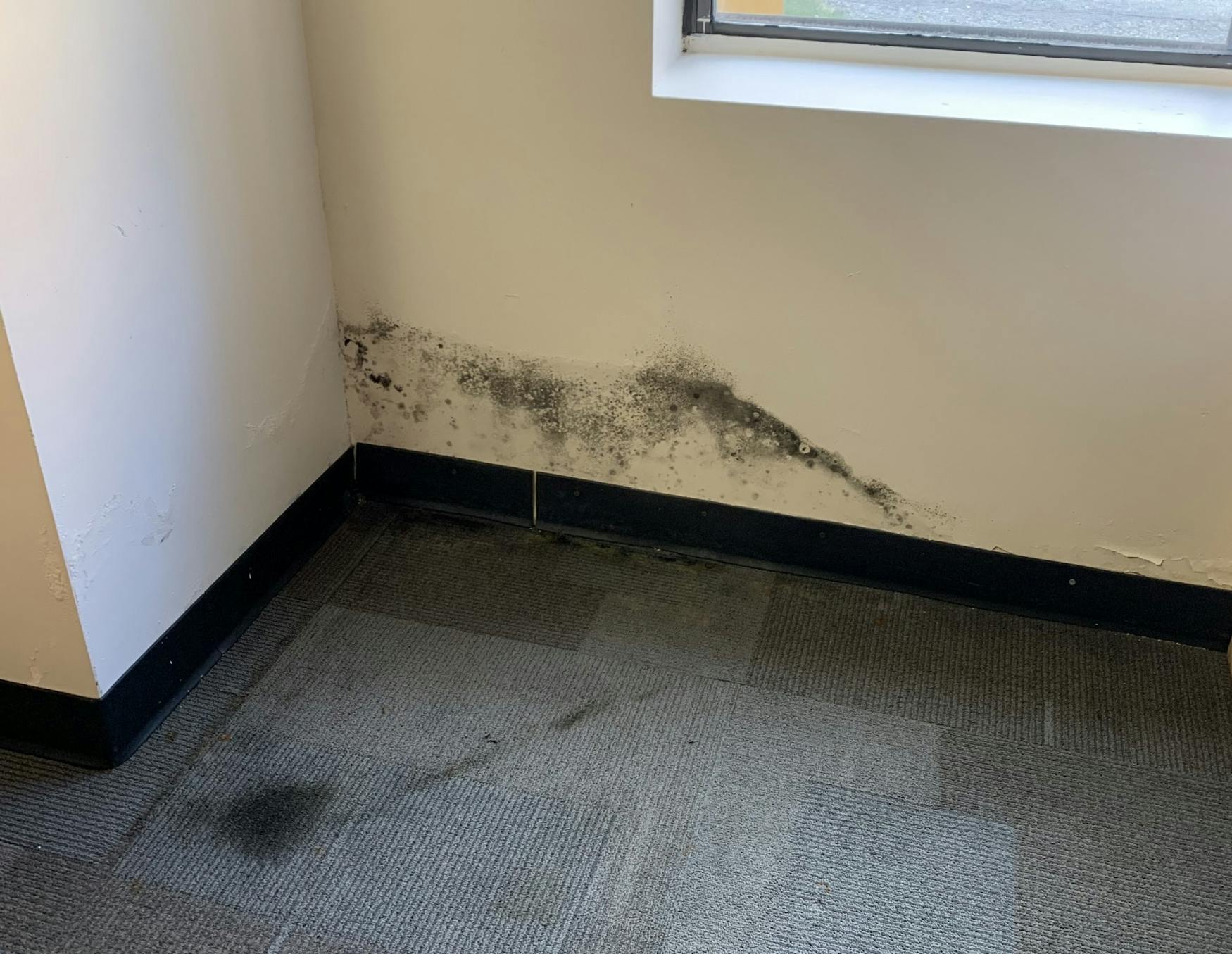Dorm disasters spark criticisms from students
The Justice listened to the stories of students experiencing issues with campus housing in the forms of mold, mice and water contamination.
$9,060 for the price of on-campus housing (2020) at Brandeis — which contributes to the University’s cost of campus living being higher than the national average by about $3,600 — would appear to be enough to cover safe and sanitary living expenses. But according to the stories of students living on campus, this is not always the case. With Brandeis’ recent push toward a series of sustainability goals, a commitment to maintaining or replacing current infrastructure to sustain a healthy environment for their students seems overlooked based on some students’ recent on-campus housing experiences. A multitude of issues that have arisen within the last month involving students’ safety, health and well-being in the dorms have suggested a campus-wide problem with regards to communication and efficiency between students and various Brandeis departments that deal with residential life, suggesting an inattentive resolve to quell these issues. In most instances, students we spoke to were left frustrated and resorted to taking matters into their own hands.
Mold in Ziv
The Ziv Quad suitemates requested to stay anonymous as the situation remains unresolved.

MOLD: In a Ziv Quad suite, black-colored mold was present on a wall.
Tuesday, Aug. 24 marked the first day of move-in for six upperclassman students living in one of the buildings that make up Ziv Quad. To them — and their parents’ — surprise when they entered the dorms and started to unpack, they were greeted by mold that was black in color along the walls in one room. As they looked around the rest of the suite, they found large patches of green mold under a bed, in the closet of another room and on the desk and dresser of a third room. It didn’t stop there — mold was also all over the carpet and cabinets in their common room.
When they reported the rampant mold to the Department of Community Living and Facilities, they were given the keys to dorms in Rosenthal for about a week. “During this time, we were in two groups of three. Half of us were in the emergency suite in Rosie East and half of us joined a suite with people we did not know in Rosie South,” said the suite members in a text message to the Justice on Friday, Oct. 1. They requested to remain anonymous due to concern with ongoing communication with DCL. They further explained, “we were able to get keys to the new space fairly quickly but were not assisted with the moving process at all, which also happened to be quite late at night.”
Six days later on Sat. Aug. 30, DCL informed the Ziv suitemates that the room had been cleaned and that the mold was gone. According to the suitemates, they received a short email response from DCL which read: “We removed affected areas. Patched and painted. Replaced carpet tiles, not many. We cleaned and shampooed the whole carpet. We cleaned and sanitized the whole area including all surface areas.”
But when the suitemates looked in their rooms after the first cleaning, they were disappointed to find that none of the affected wood was replaced — just wiped down. The suitemates emphasized the fact that the blurb made no mention of “checking the suite for other affected areas such as air vents or closets,” which struck them as odd to leave out, as mold grows in moisture-rich environments and the source of the moisture could’ve been linked to the suite’s HVAC system.
Despite lingering reservations, the suitemates moved back into Ziv that evening, the mold mishaps seemingly resolved.
About two weeks later, on Thursday, Sept. 14, one suitemate started to notice mold allergy symptoms. “[One of our suitemates] was diagnosed with mold and dust allergies after becoming mildly symptomatic in Rosenthal last spring,” said the source. “After moving back into Ziv from Rosie, [they] started noticing allergy symptoms: sore throat, congestion, cough, exhaustion and headache…which were confirmed allergy symptoms by their doctor.” When they found more mold, the suitemate with the allergy stayed with a friend temporarily and later went home where their “health improved but is [currently] not at 100%.”
A month since the Ziv suitemates’ move-in day, their uncertainty involving their dorm mold issue remains unresolved. Besides the fact that the student with the mold allergy (living in Brandeis temporary housing since Sept. 23) is still going through the process of attaining housing accommodations from DCL, the suitemates continue to be troubled by their lack of knowledge on “treatment for any underlying issues that may be causing the mold to begin with,” said the source.
While DCL told the Ziv suitemates that “none of the mold in the suite puts students’ health at risk” they glossed over the fact that the mold did, in fact, put a student’s health at risk in this case — the student with the mold allergy — and that mold present in the dorms has the potential to put other students’ health at risk in the future if they too discover or develop an allergy to mold.

MOLD: In a Ziv Quad suite, green-colored mold was present on the side of wood furniture.
An Aug. 13 article in The Oberlin Review — the student newspaper of Oberlin College — argues that even though there is “limited research or regulation related to the health impacts of mold,” it is essential to raise awareness on the topic. In Ohio, where Oberlin College is located, legislative action is currently in the works to bring light to the issue: “House Bill 251 … the Ohio Indoor Safe Air Act, is cosponsored by State Representatives Joe Miller and Allison Russo. The bill would require that the director of the Ohio Department of Health create a public awareness program about the threat of mold exposure, and that the ODH would treat mold exposure on an equal par as radon and lead exposure.”
The issue of mold is not unique to Ziv Quad on campus (with past reports from students living in Masell Quad, the Village and Rosenthal Quad). Some sources offer suggestions to address the problem, which could range from instituting “more in-depth check of rooms after move out during the summer,” (per The Brandeis Hoot article), to informing students about mold-prevention tips through signage, or simply listing tips on the Brandeis website to rule out the assumptions that students already have this knowledge at their disposal. Many other universities including University of Southern California, George Washington University and Boston University have done this.
For the Ziv suitemates, more diligent communication could’ve aided the already stressful and inconvenient aspects of their dorm mold situation. They found that DCL, who served as communication intermediaries between them and Facilities, did not break down what was happening with their situation in a satisfactory manner. “We have not seen any effort to remediate the issue — just band-aid solutions to get rid of mold as it appears,” the students wrote. “We were not updated about any progress or updates [and] almost all communication with DCL was initiated by us.” The students added that DCL “often” did not provide answers to their questions.
— Juliana Giacone
Mice in Gordon
In early September, rumors began to fly around Gordon residence hall, North Quad — four-legged rumors that squeaked and scurried. According to Yael Snowise ’25, a first year living in Gordon, a larger problem was nesting in the hall’s walls. Snowise explained that one first-year claimed to have seen a mouse enter her room, but then couldn’t find it. Afterward, other students started to notice holes in their rooms, close to the central heating units.
“It was like a mouse highway by the heaters,” Snowise told the Justice on Sept. 29 over text.

MICE: A mouse hole was sealed by Facilities.
Snowise said that by Rosh Hashanah, a Community Advisor had put in multiple work orders for the Facilities administration to come and address a possible mouse infestation after she found a mouse in her room. But without photographic proof of the mouse’s existence, the CA didn’t get a response from Facilities. Currently, the Facilities policy qualifies pest control under the least prioritized maintenance category, routine maintenance and necessary service needs. According to their website, it typically takes 14 days to initially answer a work order for pest control.
With no immediate response to the multiple work orders, students resorted to getting rid of the mice on their own. “No one was coming, because we didn’t have proof. So a student bought poison traps and handed them out to residents,” said Snowise.
On Sept. 13, Snowise woke to a dying mouse on her floor. “I thought it was dead. So I sent an SOS out to my floor for help moving it. This girl came with a soda can and a plate to pick it up, and by then it was moving a little. So we carried it outside,” she said.
Afterward, Snowise took a picture and brought it to her CA, at which point a janitorial team arrived promptly to address the issue. “We gave permission for them to come into our rooms,” she said. “Every single room on our floor had a hole — some big, some small. Mine had two. They sealed them, finally. We were all frustrated. The dorms should have been checked before we arrived — we’re going to Brandeis, we don’t expect to see mice running around.”
According to the Center for Disease Control and Prevention, mice infestations should be taken seriously. Worldwide, rodents can be carriers of up to 35 diseases. Such diseases can be spread to humans by rodent feces, urine and bites, as well as any parasitic insects such as ticks that might be hitching a ride on the rodents. Additionally, Boston is ranked the #2 city in the nation for rodent infestations, according to U.S. Census data.
— Cayenn Landau
Contaminated water in Cable

CONTAMINATED WATER: This photo of North Quad’s Cable Hall can be found advertised on the Brandeis website.
Recent speculation over possible contaminated water in Cable Hall within North Quad has sparked concerns and frustrations among students. The first victim of the water appeared around Sept. 2, but students did not realize that the water may have been the culprit until Sept. 6. A pie made by first-year student and Cable Hall resident Vincent Calia-Bogan sparked the mystery.
The pie was made from completely fresh ingredients and was baked thoroughly, and yet, many students who consumed it almost immediately got sick. “Everyone who got sick (though not everyone who ate the pie got sick) reported gastrointestinal issues that started within an hour after eating the pie. They all stated that it did not taste off when they were eating it. They also all reported that after a good amount of time on a toilet within 24 hours after eating the pie, they were completely fine once more.…this all strongly suggests that the cause of sickness was chemical in nature rather than bacterial,” Calia-Bogan wrote in an email to the Justice on Sept. 30.
After a similar encounter with mac n’ cheese that was cooked with the same water, Calia-Bogan decided to take matters into his own hands and conduct an experiment to try and solve the water mystery. He filled one cup with tap water and another with filtered water. He mixed a layer of oil into each cup of water and left them to sit for more than half an hour. When Calia-Bogan returned, he noticed that while the oil in the filtered water had settled in a layer at the top, this was not the case for the tap water. “Rather than form a uniform layer atop the water, the olive oil layer was interrupted by particulate water within the oil layer as well as on the surface. It had not fully mixed in with itself yet to become uniform, and there were at least 5 distinct globs of oil,” he said.
Following some research, Calia-Bogan concluded: “There are a family of organic chemicals called emulsifiers that are soluble in water and [break down] lipids (aka oils). They bubble and foam in increased amounts; we are all very familiar with these chemicals in the form of everyday hand soap, dish soap and laundry detergent,” he told the Justice. Calia-Borgan decided to research the effects of consuming soap to confirm his theory. The results were concerningly similar to the symptoms experienced from the pie and mac n’ cheese, leading him to verify his speculation: “it seemed like we had our culprit right there: excess emulsifiers in the water.”
Although the victims of the water have recovered and the reactions have stopped, students are irate that much of the information they have received regarding the status of the water is a result of their own speculation, rather than residential departments checking-up and updating them.
“Even after the students had established that the issue was the water, we received no official communication that the issue was being investigated [by DCL or Facilities], or that they had even received our complaint,” Calia-Bogan said. He is unaware of the current status of the water, and the only information he has comes from fellow students and conjecture. “As far as the current water situation is concerned, I have not yet re-run my tests… I haven’t heard of anyone getting sick from the water in some time, which is a relief. I personally have gone out of my way not to drink the water from the tap in Cable Hall. Everyone I know is cooking with filtered water now,” he said. In attempts to fill the void left by the departments, the students in Cable Hall took matters into their own hands by taping up signs warning other students to avoid consuming the water.
Although this issue started almost a month ago, students remain furious. Another student, Sophie Kieffer ’25, who also knew about the situation, commented to the Justice on Sept. 28, “Brandeis was founded on the principles of social justice, so I believe Brandeis is obligated to share [information] about water contamination on campus [with students].”
— Leah Breakstone
DCL’s response
Although DCL is aware of the mold in some of the dorms, their knowledge of other problems that could pose risks to students’ health is limited. According to Melody Smith, an associate director of Community Living Operations, in an email to the Justice on Oct. 4, the complaints concerning mice and potential water contamination were “not anything that [they had] been notified of occurring in the residence halls.”
Smith worked with colleagues from the Facilities and Environmental Health & Safety department to provide the Justice with more answers regarding the mold. In their response, while they shared information about “mold [found] in Village B and C,” recent reports of mold in other areas on campus, like Ziv, were not mentioned. According to the email, while the mold in Village was reported in mid-September, it was unclear when it first appeared in the dorms. The email also said that ceiling mold was “isolated” to insulation on pipes, which has since then been removed.
DCL did not comment on Brandeis’ past housing issues in regards to mice, mold and potential water contamination. They also did not provide insight into reasons for the lack of warnings to students moving into their dorms, especially when it comes to checking rooms for mold.
When asked about what could’ve been done to take preventative measures with these problems, Smith responded, “There isn’t anything specifically that anyone could have done.” With regards to mold, Smith said, “if residents see moisture marks or anything that looks like mold, please report it to Facilities by calling (781)-736-8500 or placing an online work order as soon as possible.”
— Isabel Roseth
Editor’s note: Cameron Cushing is an editor on the Justice and a Community Advisor for DCL. He did not contribute to the reporting or editing of this story.



Please note All comments are eligible for publication in The Justice.